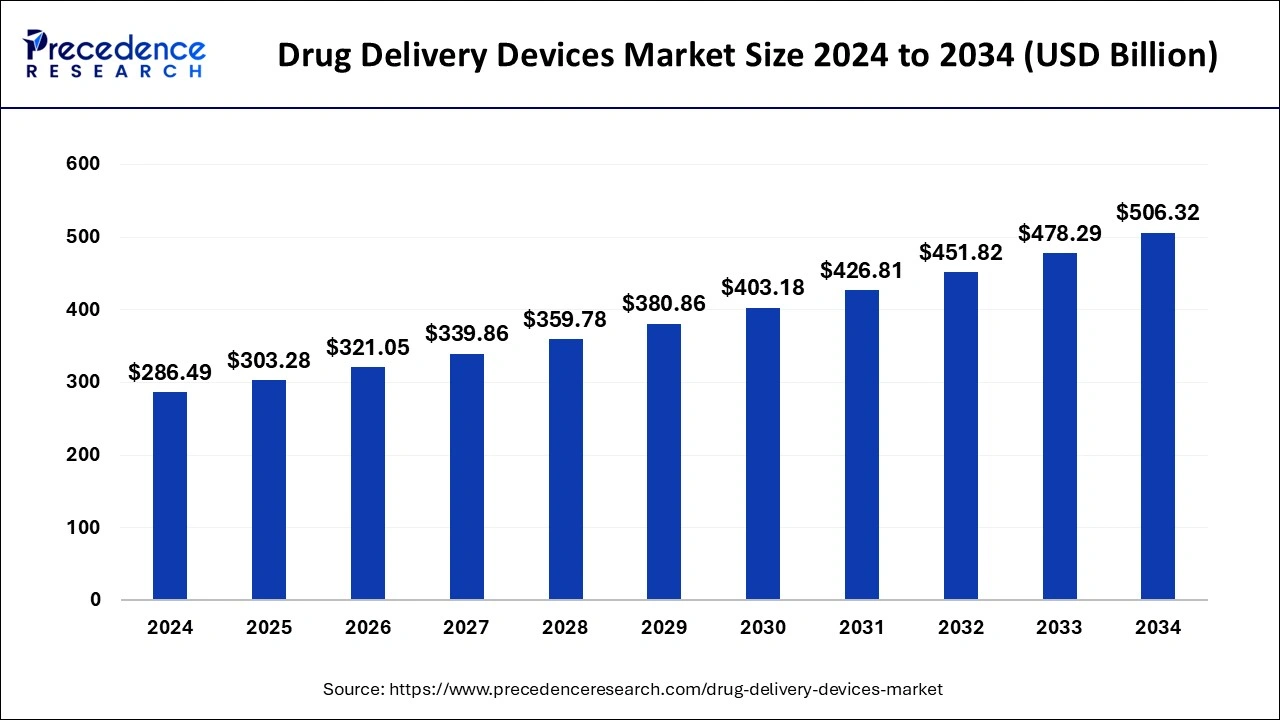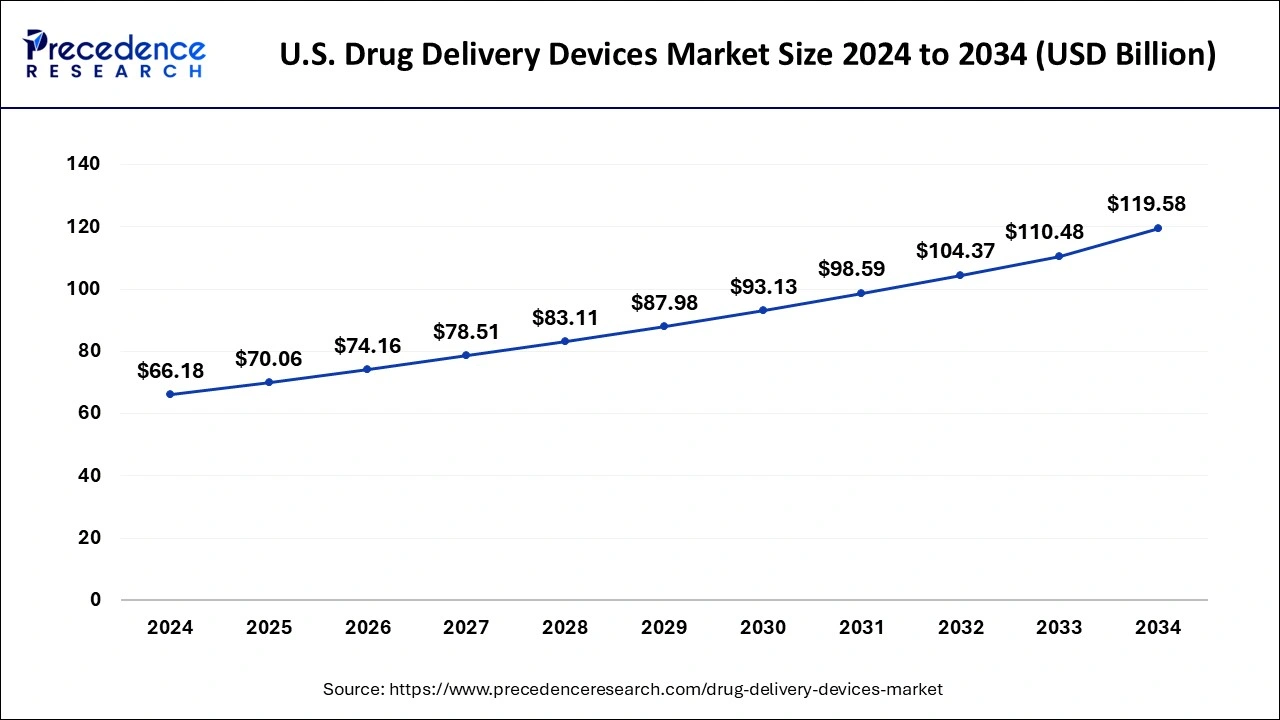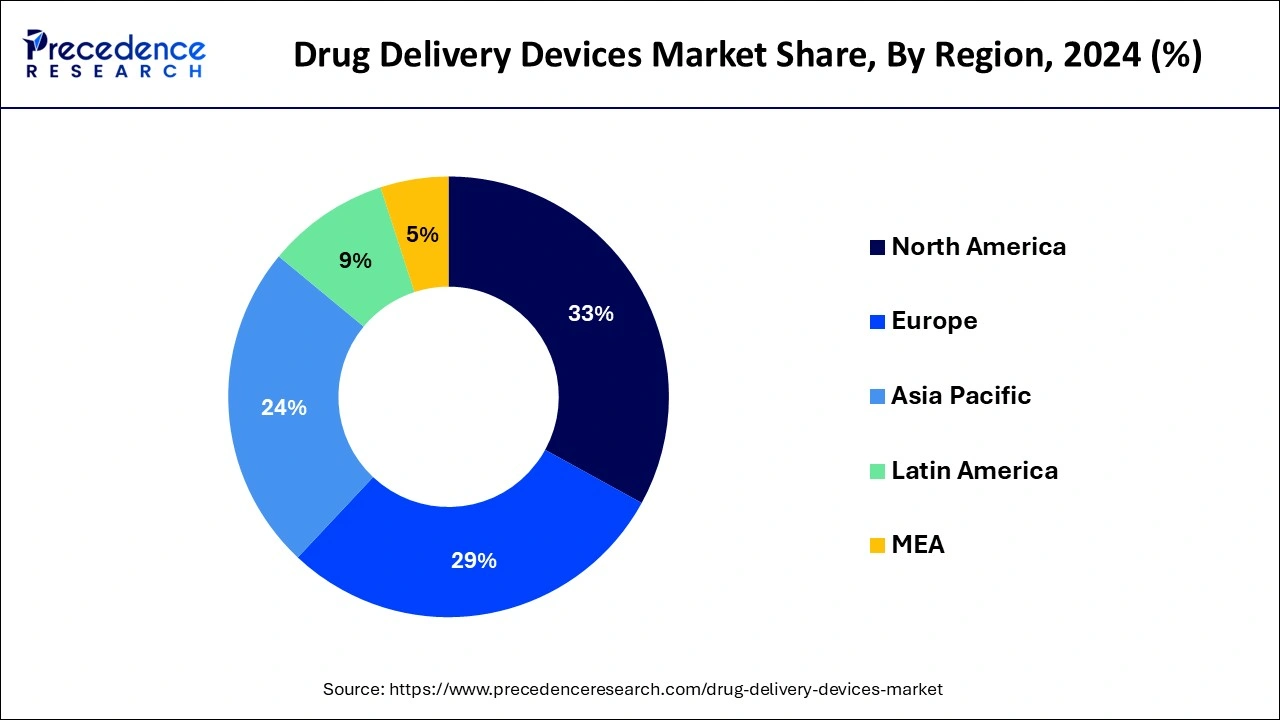August 2024
The global drug delivery devices market size is accounted at USD 303.28 billion in 2025 and is forecasted to hit around USD 506.32 billion by 2034, representing a CAGR of 5.86% from 2025 to 2034. The North America market size was estimated at USD 94.54 billion in 2024 and is expanding at a CAGR of 6.02% during the forecast period. The market sizing and forecasts are revenue-based (USD Million/Billion), with 2024 as the base year.
The global drug delivery devices market size was calculated at USD 286.49 billion in 2024 and is predicted to reach around USD 506.32 billion by 2034, expanding at a CAGR of 5.86% from 2025 to 2034. The rising adoption of innovative technology for effectively delivering drugs to the desired site is a key factor driving the market’s growth. Moreover, rising technological advancements in medical devices and awareness about self-medication contribute to market expansion.

The emergence of artificial intelligence has paved the way for the development of smart drug delivery devices. AI optimizes medication delivery methods by analyzing patient data, ensuring medications are given at the right time and in adequate amounts. This precision further helps improve treatment outcomes and reduce side effects. In addition, AI-powered devices also help monitor medication effects, thereby enhancing patient care.
The U.S. drug delivery devices market size was exhibited at USD 70.06 billion in 2024 and is projected to be worth around USD 119.58 billion by 2034, growing at a CAGR of 6.09% from 2025 to 2034.

Based on region, North America accounted largest revenue share in 2024. This is attributed to the rising prevalence of various chronic diseases such as diabetes, cancer, and CVDs in US. Moreover, the increased health consciousness and increased healthcare expenditure in US has boosted the growth of the market.

Asia Pacific is estimated to be the most opportunistic market during the forecast period. This can be attributed to the rising prevalence of various diseases due to the changing consumption pattern and unhealthy food habits of the population. Moreover, the rapidly growing geriatric population is expected to fuel the market demand as the old age people are more prone to the diseases. According to the United Nations, 80% of the global geriatric population will be living in low and middle-income countries.
The technological advancements in the medical device manufacturing has led to the development of innovative drug delivery devices that ensures right amount of medicine is administered to the patient at the right time. Moreover, the rising burden of chronic diseases such as diabetes, CVDs, cancer, and COPD is fueling the demand for the drug delivery devices.
The rapid growth of the biopharmaceutical industry is resulting in the development of various new drugs that are effective in treatment of various diseases. The rising investments by the drug manufacturers in the clinical trials and the active role played by the various authorities like FDA and EMA is boosting the development of innovative new drugs. The new to the market drugs sometimes requires innovative delivery devices, which boosts the need for the various drug delivery devices. Moreover, the presence of several top players and the developmental strategies like acquisitions, mergers, collaborations, and new product launches augments the market growth. Furthermore, the increasing investments in the marketing activities by the market players positively impact the market growth.
| Report Highlights | Details |
| Market Size in 2025 | USD 303.28 Billion |
| Market Size in 2034 | USD 506.32 Billion |
| Growth Rate | CAGR of 5.86% From 2024 to 2034 |
| Largest Market | North America |
| Fastest Growing Market | Asia Pacific |
| Base Year | 2024 |
| Forecast Period | 2025 to 2034 |
| Segments Covered | Route of Administration, Application, End User, Region |
| Regions Covered | North America, Europe, Asia-Pacific, Latin America, and Middle East & Africa |
Based on the route of administration, the oral segment dominated the largest market share in 2024. This is attributed to the increased popularity of the oral drug delivery as it is pain-free, convenient for the patients, economical, non-invasive, and can be self-administered. Moreover, the majority of the drugs or medicines are available in the liquid, powder, and tablet forms, which are generally administered through the oral route. Hence, the huge availability of the medicines that are administered through the oral route has augmented the segment growth. Therefore, the rapid growth of the biopharmaceutical medicines had positively impacted the market growth in the past few years. Therefore, the rapid growth of the biopharmaceutical medicines had positively impacted the market growth in the past few years.
The topical is estimated to be the most opportunistic market during the forecast period. The benefits such as non-invasiveness, ease of use, convenience, and painless delivery associated with the topical route of administration is expected to drive the market growth. The topical route administration is further characterized by the introduction of time-controlled system which further boosts its demand.
Based on the application, the cancer segment dominated the largest market share in 2024. The cardiovascular segment is estimated to be the fastest-growing segment during the forecast period. The rising prevalence of CVDs among the population owing to the unhealthy food habits and inactivity is boosting the growth of this segment. This is mainly due to the increased prevalence of cancer worldwide. However, drug delivery devices play a crucial role in the treatment of cancer, as they help in delivering drug at targeted areas.
The cardiovascular segment is estimated to be the fastest-growing segment during the forecast period. The rising prevalence of CVDs among the population owing to unhealthy food habits and inactivity is boosting the growth of this segment. According to the World Health Organization (WHO), CVDs are among the leading causes of death globally, taking an estimated 17.9 million lives each year. According to the World Health Organization, CVD accounted for 32% of global deaths in 2019.
Based on the end user, the hospitals segment has held revenue share of over 29% in 2024. This is due to the increased penetration of the hospitals across the global. The rising investments by the government and the corporate sector in the development of the hospitals had contributed to the growth of this segment. Moreover, the increased number of hospital admissions is further fueling the segment’s growth. The diagnostics senters segment has generated revenue share of 25% in 2024.
On the other hand, the home healthcare segment is estimated to be the most opportunistic market during the forecast period. The increasing geriatric population, increased disposable income, rising demand for getting the treatment at home, and increased awareness regarding the hospital acquired infections are the major drivers of this segment.
Key Companies & Market Share Insights
The market is moderately fragmented with the presence of several local companies. These market players are striving to gain higher market share by adopting strategies, such as investments, partnerships, and acquisitions & mergers. Companies are also spending on the development of improved products. Moreover, they are also focusing on maintaining competitive pricing.
The various developmental strategies like acquisitions and mergers fosters market growth and offers lucrative growth opportunities to the market players.
By Route of Administration
By Application
By End User
By Geography
For inquiries regarding discounts, bulk purchases, or customization requests, please contact us at sales@precedenceresearch.com
No cookie-cutter, only authentic analysis – take the 1st step to become a Precedence Research client
August 2024
June 2023
January 2025
November 2024